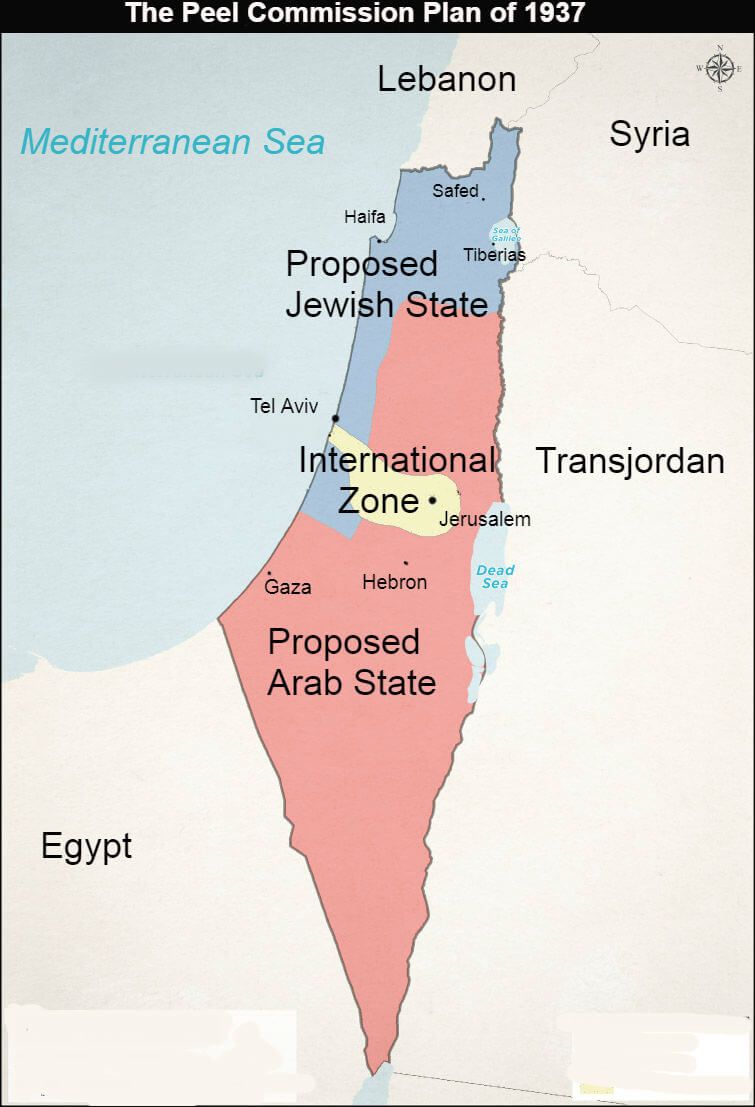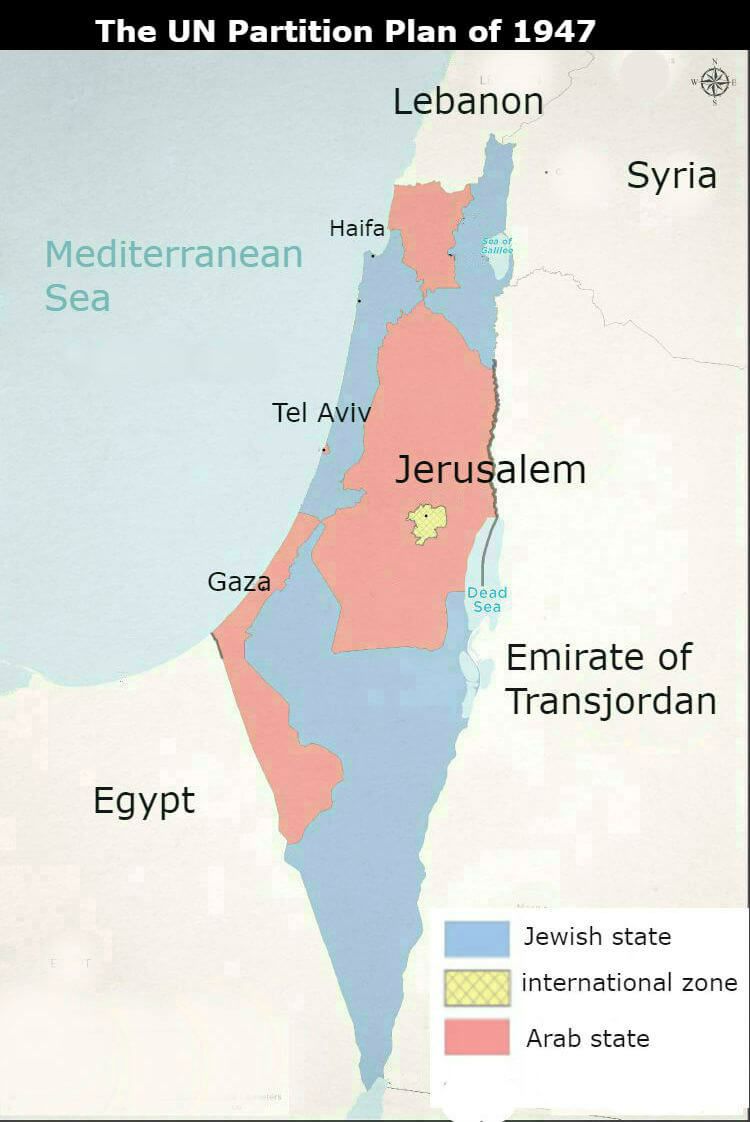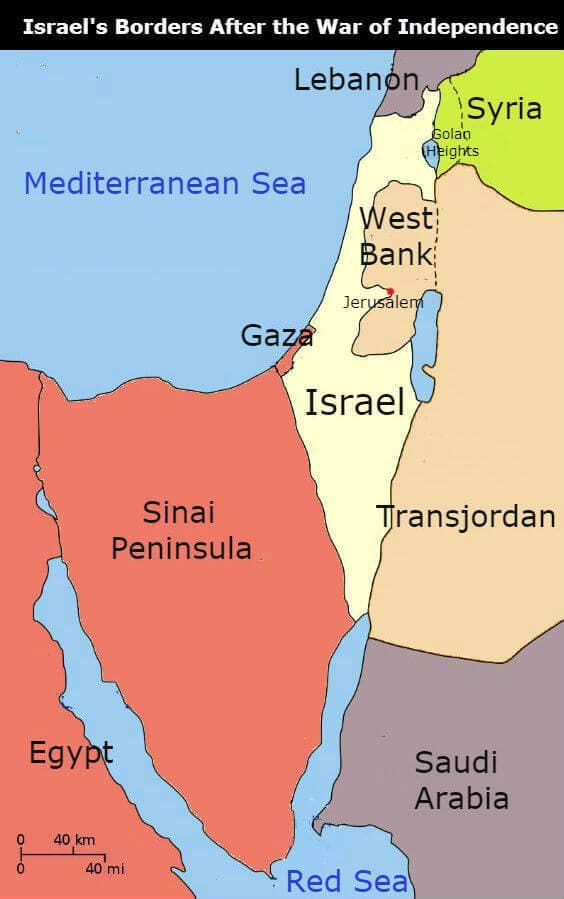The United Nations’ adoption of the 1947 Partition Plan was a key moment in the Israeli-Arab conflict, as the international community formally endorsed the creation of Jewish and Arab states side by side. Anti-Israel chants of “From the river to the sea, Palestine will be free” ignore the history of the conflict.
Although conflicts and peace treaties have changed the borders from what the United Nations originally envisioned, UN Resolution 181 remains relevant for three very important reasons.
- The international community formally recognized statehood for the Jews in their historical homeland.
- The Partition Plan called for two states for two peoples, which continues to be Israeli policy.
- Arab rejection of the Partition Plan demonstrated that they were not interested in establishing a Palestinian state if it meant recognizing the existence of a Jewish state.
There is no historical record of any Arab population striving for self-determination and their own state of Palestine prior to the early decades of the 20th century.
Let’s review the facts.
Join the fight for Israel’s fair coverage in the news
Britain’s Best Laid Plans
Following World War I, the League of Nations partitioned the entire Ottoman Empire which included Palestine and gave the British control over Palestine. The arrangement, called “the Palestine Mandate,” accepted the 1917 Balfour Declaration’s commitment to establishing a “national home” for the Jewish people in the land known as “Palestine.”
The Arabs living in the region protested the intention to establish a national home for the Jews, killing innocent hundreds of Jews including the 1929 pogrom in Hebron which took the lives of 69 Jewish residents of the city with many more maimed and injured.
Following a six-month Arab armed uprising and general strike in 1937, the British established the Peel Commission which recommended dividing the land into two states – a Jewish one and an Arab one. This first partition plan included a population transfer, to insure that Jews lived in the Jewish state and Arabs in the Arab state.
The recommendations also included a series of economic measures – including the Jewish state paying the Arab state since most of the Arab income until this point had come from Jewish employment. Jerusalem, and a stretch of land reaching to the Mediterranean, would remain under British control with international supervision.

The Arab leadership rejected the Peel commission’s partition plan while the Jewish leadership accepted it as a basis for negotiations. But a year later, the British government declared that “the political, administrative and financial difficulties involved in the proposal to create independent Arab and Jewish States inside Palestine are so great that this solution of the problem is impracticable.”
Prelude to the UN Partition Plan
Ten years of turmoil in the land followed, leading to the British decision in February 1947 to end their Mandate for Palestine. London handed the problem over to the UN. The UN Special Committee on Palestine (UNSCOP) was created to determine what to do.
The committee returned with its recommendation in August: a partition plan that left Jerusalem under international control but vastly different borders than what the Peel commission proposed.
The Jewish state would include the Eastern Galilee, the coast from Haifa to Rehovot, and most of the Negev. The Arab state would include the central and western Galilee, Acre, the high ground of Judea and Samaria (now known as the West Bank), Jaffa, and the southern coast from north of Ashdod to the Egyptian border, including the Gaza Strip.

The UN Partition Plan’s proposed Arab state made up 43 percent of Palestine including all of the high ground (not counting Jerusalem), plus one-third of the coastline. The Arab state would have control over all the main aquifers which supplied water to the entire Palestine. The Jewish state made up 56% of the land mass, most of which was in the barren Negev desert which at that time was not suitable for urban development or for agriculture. The Jewish state was given sole access to the Sea of Galilee which was crucial for its water supply.
While the plan did its best to best to separate between Jewish and Arab populations, there was going to be a large Arab minority in the Jewish state (45%), and an insignificant Jewish minority (a mere one percent) in the Arab state. The plan dictated that the Jewish and Arab minorities would become full-fledged citizens of the states in which they lived.
The Arab leadership rejected the committee’s recommendations, stating that they “concluded from a survey of Palestine history that Zionist claims to that country had no legal or moral basis.”
The Jewish leadership criticized the boundaries of the proposal but agreed to accept the plan if “it would make possible the immediate re-establishment of the Jewish State with sovereign control of its own immigration.”
But Arab leaders did not stop at simply rejecting the Partition Plan.
An Egyptian newspaper quoted Azzam Pasha, the General Secretary of the Arab League saying: “I hope the Jews do not force us into this war because it will be a war of elimination and it will be a dangerous massacre which history will record similarly to the Mongol massacre or the wars of the Crusades.”
Jamal Husseini, a member of the Arab leadership promised that if the UN proposal was accepted, “The blood will flow like rivers in the Middle East.”
Prime Minister of Iraq, Nuri al-Said, made it clear that if a Jewish state was established, “We will smash the country with our guns and obliterate every place the Jews seek shelter in.” He then went a step further and declared that “severe measures should be taken against all Jews in Arab countries.”
The threats to Jews in Arab countries continued when on November 24, just five days before the UN vote on the proposal, the Egyptian representative to the UN told the General Assembly that “the lives of 1,000,000 Jews in Moslem countries would be jeopardized by the establishment of a Jewish state.”
The UN Adopts the Partition Plan
Despite all of these threats, on November 29, 1947, the United Nations General Assembly adopted the partition plan. There results were 33 in favor, 13 against, 10 abstention, and one absent.
The Jewish people celebrated the outcome. David Ben Gurion declared, “I know of no greater achievement by the Jewish people.”
The Arabs rejected the result. Haj Amin al-Husseini,the mufti of Jerusalem told the Al Sarih newspaper that the Arabs “would continue fighting until the Zionists were annihilated.”
The Jews were well aware of the threat which they faced. Menachem Begin said that the Arabs would certainly attack and “will be a war on our existence and future.”
The War of Independence
The British Mandate ended on May 14, 1948. Earlier that day, the Jewish People’s Council led by Ben Gurion declared a Jewish state – based on the results of the November 29, 1947 UN vote for partition of the Palestine. The very next day Egypt, Jordan, Syria, Iraq, and Lebanon began their all-out attack to destroy the Jewish state.
As a result of that war which ended in stages during the first half of 1949, the Jewish state controlled 78% of Palestine, as opposed to the 56% it was given under the UN Proposal. Jordan took control of the high ground known as the West Bank, Egypt took control of the Gaza Strip, and Jerusalem was divided with Western Jerusalem belonging to Israel and Eastern Jerusalem belonging to Jordan.
Related reading: The War of Independence: The Sin of Israel’s Creation?
David Ben Gurion declared that Israel was no longer bound by the Partition Plan. As the Jews fought for their lives all alone, the UN had done nothing to implement Resolution 181, allowing the Arabs to attack the fledgling Jewish state.

In addition, a majority of Arabs – around 720,000 people – fled from the Jewish areas, leaving a much smaller Arab minority of around 20%, who were offered full citizenship in Israel. In eastern Jerusalem and the West Bank — controlled by Jordan — no Jews remained. Likewise for the Egyptian-controlled Gaza Strip.
Moreover, more than 300,000 Jews who were attacked in Arab lands during the war, made their way towards Israel and helped to populate the fledgling Jewish state.
Related reading: The Forgotten Jewish Refugees From Arab Lands
Aftermath
The Arab leadership continued its efforts to destroy the Jewish state including the Six Day War in 1967 during which seven Arab countries – Egypt, Jordan, Syria, Iraq, Saudi Arabia, Kuwait, and Algeria – sought to “Free Palestine.” During that war, Israel gained control of the West Bank from Jordan, the Sinai and the Gaza Strip from Egypt, and the Golan Heights from Syria.
Israel has made numerous proposals of swapping land for peace based on the premise of that original UN partition plan in 1947 providing for two states – one Arab and one Jewish – in Palestine.
Related reading: Three Noes That Set the Middle East On Course of Conflict
To date, two Arab countries have accepted. In 1979 Egypt gave official recognition to the Jewish state and Israel pulled out of the Sinai in exchange for peace, and in 1994 Jordan gave official recognition to the Jewish state and Israel recognized the special role of Jordan in Muslim Holy shrines in Jerusalem and agreed to provide Jordan with all its water needs in exchange for peace.
More than 80 years of conflict have proven that Palestine will not “be free” of Jews. Six million Jews now live in the strong, prosperous and flowing Jewish state. Once Arabs and their supporters around the world understand the history and come to this conclusion, efforts can be made to improve the freedoms and qualities of life of all residents of the region.
Liked this article? Follow HonestReporting on Twitter, Facebook, Instagram and TikTok to see even more posts and videos debunking news bias and smears, as well as other content explaining what’s really going on in Israel and the region.
New! Skip the social scroll and get the latest from HonestReporting via Telegram.
Before you comment on this article, please note our Comments Policy. Any comments deemed to be in breach of the policy will be removed at the editor’s discretion.

